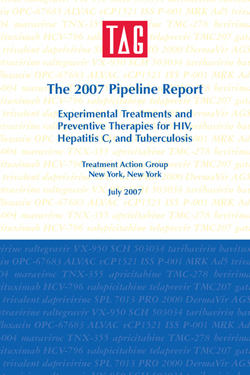Experimental Treatments and Preventive Therapies for HIV, Hepatitis C, and Tuberculosis
July 2007
By Mark Harrington, Bob Huff, and Richard Jefferys. Reviewed by Tracy Swan, Javid Syed, Claire Wingfield, and Jen Curry.
From the Introduction:
The Pipeline Report is the Treatment Action Group’s annual review of experimental technologies that have the potential to solve critical unmet medical needs surrounding HIV infection and AIDS.
Pipeline reviews—a staple of the AIDS research and treatment literature—arose in the 1980s. In that era, before effective HIV treatments existed, desperate people sought every scrap of hope about all kinds of potential therapies, whether developed within the scientific paradigm or by the lights of alternative wisdom.
Pipeline reports concisely assess how soon some critical technologies might arrive to relieve our most urgent medical needs. In 1989, the clinical pipeline for AIDS treatments trickled with a few drugs that ultimately fell short of miraculous. Basic research charged ahead nonetheless, and by 1993 experimental drugs with startlingly new mechanisms of action had appeared in the pipeline. Not until 1996 did these discoveries finally converge with accurate tools for measuring viral load and with new ideas about using combination therapy to combat drug resistance, resulting in the breakthrough known as HAART.
In 2007, with over 20 approved HIV medications, we no longer feel the same urgency about every single new candidate at every stage in the development process, and this year’s Pipeline Report limits itself mainly to drugs that have a reasonable chance of becoming approved products within the next several years. Earlier phase I studies are often exploratory outings that go no further, and some large companies prefer to keep quiet about initial clinical research until there is confidence about the putative drug’s safety and activity. Staying abreast of advances in basic science and new theoretical approaches to treatment is important, but progress in solving the many pressing problems that face people living with HIV and its complications is what really matters. Ultimately, the pipeline exists to produce solutions.
For example, tuberculosis (TB) is the worst killer of people with HIV worldwide, and the greatest impediment to curing TB is the lack of a simple, reliable test to identify who actually has the disease and requires treatment. Therefore, we desperately need to see new TB diagnostics in the pipeline. The next priority is more traditional: better drugs to treat and cure people with multidrug-resistant TB. Although research activity in both of these arenas is heating up, investment remains miniscule compared to the scope of the problem.
Millions of cases of hepatitis C virus (HCV) infection go untreated, and liver damage caused by HCV can greatly complicate HIV therapy. Research is burgeoning as small and large companies alike scramble to bring a breakthrough HCV therapy to market. But breakthroughs don’t come easily, and it is difficult to predict which new agents will prove valuable. One obstacle: significant uncertainty remains about the best way to scientifically demonstrate that certain new HCV drugs are doing what we think or hope they are.
Basic science research on the most critical unsolved mysteries regarding the immune pathogenesis of AIDS may finally be yielding new ideas about the role of immune activation in the progressive loss of CD4 cells. If not certain knowledge, at least some new theories are emerging as the field of AIDS immunology enjoys a rare period of thaw and fertility.
The pipelines for prevention technologies remain unproductive. Two of the first few simple microbicide candidates have foundered in latestage studies, while more sophisticated products are still snagged on technical problems. Meanwhile, hope springs eternal on the glacial plains of vaccine development. Although many core questions that hold this field back remain unanswered, the coming year may bring significant news, if not real progress.
The quest for better drugs to treat HIV infection will likely produce the biggest impact during the next 12 months. The anticipated arrival of three important new antiretroviral drugs is generating excitement about a potential shift in how HIV will be treated in the future. It is too soon to say if such talk is justified, but 2008 may be a year in which many people who have long struggled with multidrug-resistant HIV finally see their viral loads brought under control.

